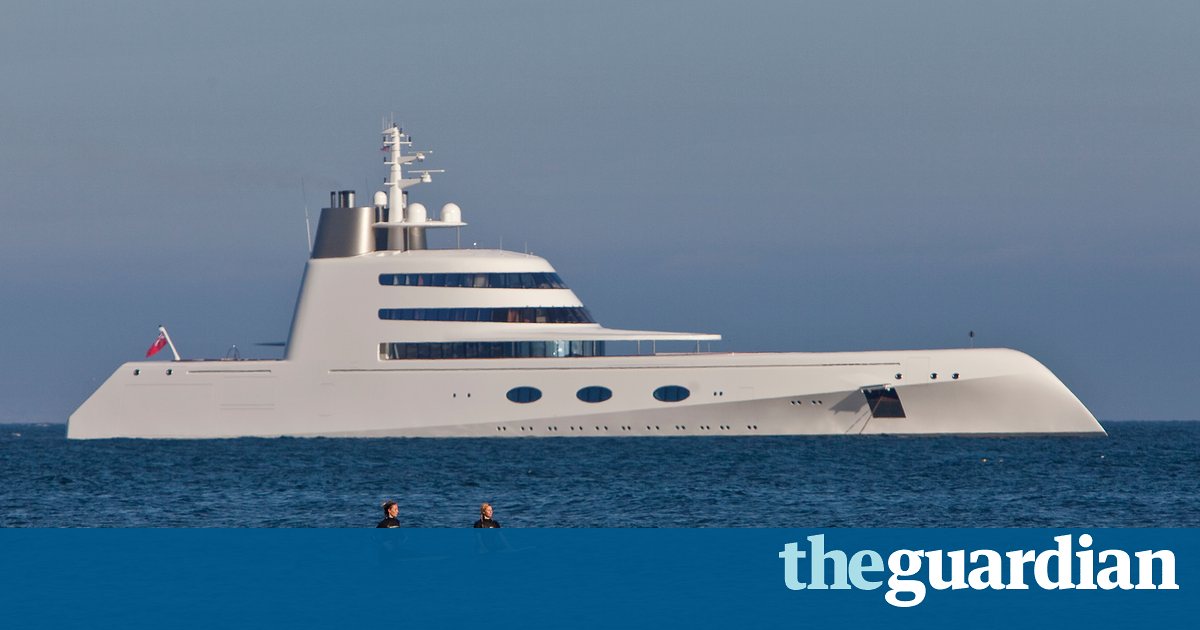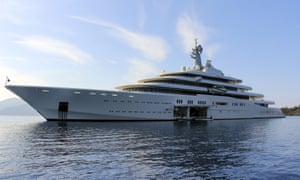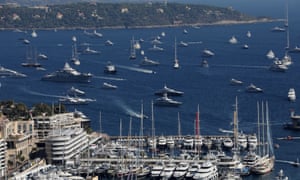Superyachts and bragging rights: why the super-rich love their floating homes

An academic spent six years studying the lavish boats of multimillionaires. Her conclusion: showing off the owners wealth and status matters more than travel

As conspicuous displays of wealth go, the mooring of Motor Yacht A owned by Russian tycoon Andrey Melnichenko last month on one of the most striking spots on the Thames, next to D-day warship HMS Belfast by Tower Bridge, was hard to top. One of the worlds largest superyachts, the Philippe Starck-designed, 119-metre (390ft) white vessel which features three swimming pools, a helipad and bombproof glass embodies an exclusive lifestyle that is highly visible but inaccessible to all but the global financial elite and their entourage.
But Melnichenko, who made his 9.2bn fortune in coal and fertilisers, has put the distinctive boat up for sale after upgrading to the 347m, 143-metre Sailing Yacht A, believed to be similarly named to ensure it is listed first in shipping registers. His new vessel, which features three carbon masts more than 90 metres tall with a sail area greater than a standard football pitch, is the tenth-largest superyacht in the world. It propels him into the premier league of private yacht owners alongside fellow oligarch Roman Abramovich, whose 162.5-metre Eclipse is currently the second-largest.
The Chelsea football club owners spectacular 724m vessel, which made headlines last summer when it briefly moored on the river Clyde in Scotland, far from its usual cruising grounds, is believed to feature two swimming pools (one of which has an adjustable depth that allows it to be converted into a dancefloor), an exterior fireplace, a leisure submarine, armour plating, bulletproof windows, a missile defence system and an anti-paparazzi shield designed to dazzle digital cameras.
But one British academic has managed to penetrate this elusive milieu. Emma Spence has spent the last six years researching the industry, has crewed on superyachts around the world and shadowed a yacht broker in the tax haven of Monaco, observing how the boats are deployed to establish a pecking order among the super-rich. The researcher is completing a PhD on the superyacht scene and says the vessels are unique among prestige assets: unlike private jets they are not a useful mode of transport; unlike art and property, they always depreciate in value. Instead, as one owner told her, what makes a yacht desirable is that it allows the super-rich to perform their wealth status.
Superyachts are defined as boats with hulls that measure longer than 24 metres at the waterline and that require a professional crew to operate. With basic annual maintenance and operation costs expected to be 10% of the original purchase price, ownership is the preserve of multi-millionaires and billionaires.
In a forthcoming book on the lifestyles of the super-rich, Spence explains how merely possessing these elite craft is not enough to enhance the profile of the super-rich; how and where the yacht is used is equally important. This is why most owners and charterers of the luxury vessels prefer to go to prominent ports with bars and restaurants where they can guarantee an audience of super-rich peers. Her research focused on the Cte dAzur, the centre of the superyacht scene, where hundreds of luxury vessels line the docks in Saint-Tropez, Nice, Antibes, Cannes and Monaco, the most prestigious port in the Mediterranean.
Among the owners she witnessed projecting their status were billionaire retailer Sir Philip Green, who took delivery of his third superyacht the 100m, 90-metre Lionheart, his second boat to bear that name earlier this year. While she was crewing on a yacht belonging to somebody else in Saint-Tropez in 2013, Green came on board without invitation. He walked up on the aft deck in board shorts and a T-shirt standard super-rich attire, as casual as you can be, she says. The grownup children [of the owner] and friends all immediately stood to attention until he told them it was OK to sit down. Ive never seen anyone else command that respect on someone elses yacht.
The perma-tanned Topshop tycoon recently finished a two-month Mediterranean cruise with his wife, Tina, leaving their daughter, Chloe, on board in Monaco, where yacht owners and industry insiders gathered last month at the worlds most prestigious yacht show to size up one anothers nautical assets. The familys got a permanent berth there and Ive docked alongside him for many years, says Spence. One time, years ago in Monaco, a rival crew climbed on board in the night and changed the boats name with tape to Lion Fart.

Some yacht owners are attracted to tourist resorts in the French Riviera because an integral part of their lifestyle is projecting their privilege beyond their elite peer group, Spence adds. You have this tension between the privacy that yachts and the sea afford against this desire to see and be seen, she says. Tourists remind the super-rich of their wealth and their social status. In Saint-Tropez, you have hundreds of people on the docks as the yachts come in. The guests sit there on the aft deck. Most of these people you wouldnt know if you passed them in the street. Theyre not celebrities. But when they finally descend [ashore] theres still this awe.
Spence saw how a group of young men who were children of superyacht owners often encourage this fascination with their way of life. Each night, theyd go to big clubs, such as the VIP Rooms in Saint-Tropez or Gotha in Cannes, spend 5,000, 10,000 on a table and buy huge bottles of Dom Prignon with sparklers, she says. Theres a group of young women that spends the day going from one port to the other, getting entry to these clubs and schmoozing these wealthy young men. The women come on board the boats, go up to the top deck and ask for champagne. Theyre all drunk and youre trying to explain at 3am that they cant wear stilettos on board.
While in the clubs of the Cte dAzur, uber-wealthy heirs might lavish money on these hangers-on, but back on their parents yachts, their attitude changes. On board, its the parents stack of wine its not something to be given away, says Spence. The older son of one owner came down to check I was serving the cheapest champagne. You downgrade from vintage Dom to Veuve Clicquot from 100 euros a bottle to 30 euros.
The super-rich also use their yachts to control the level of access they grant to those outside their wealthy circle, says Spence. For example, some exploited maritime law to get rid of the young women they brought back from the clubs. In the morning, they would go to bed and order the yacht to leave port, knowing the crew would have to remove any stragglers before they set sail. If youre in port then you can have as many people on board as you want but at sea you can only have 12 passengers, unless you have large-yacht certification, says Spence. The owners sons would just slink off to their cabins leaving a few random women dotted around the yacht. Its awkward when these people think theyre going to stay and spend the week partying on a yacht and then theyre unceremoniously kicked off.
The symbiotic relationship between superyacht owners and crew is not as one-sided as it might appear. During the Monaco Grand Prix, securing the most prestigious berth on the T-jetty the first row of yachts on the race start line is reliant on the captains contacts, not the owners, says Spence. Its knowing who to pay extra to for the privilege. Its a reflection of the owners status, but its done via the connections of the crew. If your captain speaks fluent French and has worked in the industry for years, then theyll have much a better chance of getting into a prominent position in the port.
The whole industry is completely gendered, says Spence. The interior crew are women and the deck crew are male. Ive come across two female captains in six years of researching the industry, and I know of two chief stewards who are female. The women retire because owners dont want them in the interior of a boat after a certain age late 30s and youre off.
The majority of owners buy superyachts secondhand via brokers and refit them to their tastes. Camper & Nicholsons put the global number of yachts of at least 30 metres at 4,476, with 268 sold via brokers last year at a total cost of $2.68bn (2.18bn), or an average of $10m. They estimate that 222 yachts of over 30 metres have been bought worldwide so far this year. The next step up is to buy or commission a series yacht from a shipyard, which will have the same cabin configuration, exterior style and machinery across the line, but the owner will dictate the furniture and furnishings. The top tier are custom-designed by naval architects and can take shipyards several years to complete.
Peter Thompson, a broker at Monaco-based Thompson, Westwood and White Yachts, says eastern European oligarchs and Gulf royals dominate the 100-metre-plus superyacht market, also known as gigayachts.
The primary factor behind the increasing size of superyachts is the growing wealth of the super-rich. The number of ultra-high-net-worth individuals, with net assets of at least $30m, rose by 61% between 2005 and 2015 to 187,468 worldwide, according to the latest wealth report by estate agent Knight Frank. Of these, Credit Suisse calculates that the number worth at least $100m rose from 30,000 in 2010 to 44,900 in 2015, while those with assets above $500m increased from 2,800 to 4,500 in the same period.

Broker Simon Goldsworthy, of luxury yachting specialists Camper & Nicholsons, says: The client who 15 years ago would have been satisfied with a 40-metre [yacht], which would then have been one of the largest yachts in the bay, is now surrounded by dozens of yachts of 60-70 metres, and this plants the seed that he really ought to upgrade.
Innovative design has also played a part there are things you can fit onto a 60-metre yacht that you simply cant fit on to a 40-metre one, such as infinity pools, helipads, cinemas, dive rooms, and so on. Evan K Marshall, a London-based superyacht designer, says many of his clients yachts are more expensive, and far more personalised, than their homes. Within the circles of friends who own vessels, there is a healthy competition, he says. If someone says: Oh, Ive just ordered an 80-metre, his friends going to be on the phone to his broker: Listen, Im thinking of building an 85-metre! We love that.
Among Marshalls most prolific clients is the Brooklyn automotive tycoon John Staluppi, who names his boats after James Bond films. Last year, he ordered his 19th superyacht, the 66-metre Spectre, due to be delivered by the Italian Benneti shipyards in 2017. Thompson, who was involved in many of the projects, says Staluppi gets a new superyacht every 18 months to three years, compared with a client average of every five to seven years. The first one I did was The World is Not Enough, then he sold that and bought Quantum of Solace, then he sold that and bought Casino Royale, then Diamonds are Forever. Right now weve got Skyfall and theres Spectre on the way. He loves the creation side of it. But he doesnt travel a lot. He uses them as floating homes.
In the French Riviera, many owners flip between staying on board their yacht or in their luxury villas or mansions, says Spence. They would have a fully staffed house and the boat doing exactly the same thing, 20 minutes drive away. Youd both be on call, so you wouldnt know when the owner would turn up at the house or the boat. So you would have a system that the staff at the house would call ahead to the boat, and the owners would appear 10 minutes later and youd just happen to have fresh towels and scented water waiting for them.
In recent years, a growing number of superyacht owners and charterers, particularly those under 40, have cruised further afield than the milk run of Mediterranean resorts to remote routes, including the Arctic Northwest Passage, fuelling demand for designer icebreakers, such as the SeaExplorer range. William Mathieson, editorial director of the Superyacht Group, says this trend for expedition yachts is due to an emergent younger super-wealthy class from heirs to dotcom billionaires who want to chase an elusive experience. Although some owners might pursue remote and exotic adventures, he suspects that for others it will become the yachting equivalent of the Chelsea tractor.
While Spence says this trend partly reflects that yachting still involves romanticised notions of escape, it is also rooted in owners preoccupation with bragging rights.
She crewed on one yacht that was sailing around the world; the owners would just fly in when it reached a certain port of call. They would leave it in the Med then fly down to Mauritius, then would fly back again when its in India, she says. Youre really using it as a floating hotel. They would eat meals on board and pop off to do a bit of shopping.
Having their yacht in far-removed locations is a social statement in itself, even if they do not make it on board themselves. Even mooring your yacht on the Thames is conspicuous in that it is far removed from the south of France where all the other yachts are.

The worlds top five superyachts
1. Azzam
Built: 2013.
Owner: believed to be Sheikh Khalifa bin Zayed Al Nahyan, the emir of Abu Dhabi and president of the United Arab Emirates.
Cost: estimated to be $400m.
Length: 180 metres.
Special features: Her interior is believed to be in a relaxed French Empire style.
2. Eclipse
Built: 2010.
Owner: Roman Abramovich.
Cost: 724m.
Length: 162.5 metres.
Crew: 70.
Special features: Three-person leisure submarine, two swimming pools, one of which has an adjustable depth feature that allows it to be converted into a dance floor, a missile defence system, and an anti-paparazzi shield that fires light beams to target and disrupt digital cameras.
3. Dubai
Built: 2006.
Owner: Sheikh Mohammed bin Rashid al-Maktoum, the emir of Dubai and the prime minister of the UAE.
Cost: estimated to be $400m.
Length: 162 metres.
Crew: 88.
Special features: The royal yacht features a circular staircase with glass steps that change colour, a mosaic swimming pool and a landing platform for a Blackhawk helicopter.
4. Dilbar
Built: 2016.
Owner: Alisher Usmanov, Russian billionaire and one of Arsenal football clubss main shareholders.
Cost: $452m (estimate).
Length: 156m.
Special features: 41,000sq ft of living space and two helipads.
5. Al Said
Built: 2008.
Owner: Sultan Qaboos bin Said Al Sad of Oman.
Cost: Unknown.
Length: 155m.
Crew: 154.
Special features: Concert hall that can accommodate a 50-strong orchestra, a helipad and a cinema.
Running costs
The annual operation costs: 10% of the original purchase price. For a 71-metre yacht, fuel usage is 500 litres an hour (an average of $400,000 per year), according to Towergate Insurance.
Docking costs: $350,000; insurance: $240,000; maintenance and repairs: $1m per year; crew wages: $1.4m.
Crew salaries
Captain: 9,000-12,000 per month on a yacht of 40 metres, rising to more than 15,000 on vessels longer than 70 metres, now commonly known as mega-yachts. Junior deckhand or a junior steward: 2,000-2,500 per month.